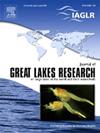Hydrology, chemistry, and sediment and nutrient loads at the intersection of the Genesee River and Erie Canal: An interbasin transfer
IF 2.4
3区 环境科学与生态学
Q3 ENVIRONMENTAL SCIENCES
引用次数: 0
Abstract
The Genesee River crosses the Erie Canal before entering Lake Ontario near Rochester, New York. Nutrient, suspended solids, temperature, conductivity, flow, and loading data collected weekly over an entire year near the intersection of the Erie Canal and the Genesee River focused on the question on how the Erie Canal impacts the Genesee River and vice versa how the Genesee River impacts the Erie Canal. Temperature, conductivity, suspended solids and P loads, mass balance, and aerial photography provided evidence for a transfer of water between the Genesee River and Erie Canal and vice versa. Temperature and conductivity of the entire water column of the canal east of the river were moderated by the warmer and lower conductivity of the canal west of the river (Canal West). At the downstream Genesee River site, conductivity and temperature provided evidence of a surficial layer created from Erie Canal water. Mass balance analysis suggested Canal West provided up to 67 % and 77 % of the inputs to the Genesee River and to the canal east of the river, respectively. The average daily Canal West phosphorus load (57.1 kg P/d) accounted for 14.8 % of the phosphorus load to the Genesee River and was higher than those of four major tributaries to the Genesee River. The high average daily load of TP and TSS (4.1 %) load from Canal West to the Genesee River represented a significant anthropogenic interbasin transfer from the Niagara River/Lake Erie via the Erie Canal to the Genesee River and Lake Ontario.
杰内塞河和伊利运河交汇处的水文、化学、泥沙和养分负荷:流域间转移
杰内西河穿过伊利运河,流入纽约州罗切斯特附近的安大略湖。养分、悬浮物、温度、导电性、流量和装载数据在伊利运河和杰内西河的交汇处收集了一整年,这些数据集中在伊利运河如何影响杰内西河,反之亦然杰内西河如何影响伊利运河的问题上。温度、电导率、悬浮物和磷负荷、质量平衡和航空摄影提供了证据,证明在杰内西河和伊利运河之间存在水的转移,反之亦然。河东运河整个水柱的温度和导电性被河西运河(运河西)的温度和导电性降低所缓和。在下游Genesee河遗址,电导率和温度提供了伊利运河水形成表土层的证据。质量平衡分析表明,运河西部分别为Genesee河和运河东部提供了高达67%和77%的输入。运河西日均磷负荷(57.1 kg P/d)占杰内塞河磷负荷的14.8%,高于杰内塞河四条主要支流的磷负荷。从运河西部到杰内塞河的TP和TSS的高平均日负荷(4.1%)表明,从尼亚加拉河/伊利湖经伊利运河到杰内塞河和安大略湖的重大人为流域间转移。
本文章由计算机程序翻译,如有差异,请以英文原文为准。
求助全文
约1分钟内获得全文
求助全文
来源期刊

Journal of Great Lakes Research
生物-海洋与淡水生物学
CiteScore
5.10
自引率
13.60%
发文量
178
审稿时长
6 months
期刊介绍:
Published six times per year, the Journal of Great Lakes Research is multidisciplinary in its coverage, publishing manuscripts on a wide range of theoretical and applied topics in the natural science fields of biology, chemistry, physics, geology, as well as social sciences of the large lakes of the world and their watersheds. Large lakes generally are considered as those lakes which have a mean surface area of >500 km2 (see Herdendorf, C.E. 1982. Large lakes of the world. J. Great Lakes Res. 8:379-412, for examples), although smaller lakes may be considered, especially if they are very deep. We also welcome contributions on saline lakes and research on estuarine waters where the results have application to large lakes.
 求助内容:
求助内容: 应助结果提醒方式:
应助结果提醒方式:


